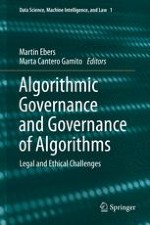Algorithms are now widely employed to make decisions that have increasingly far-reaching impacts on individuals and society as a whole (“algorithmic governance”), which could potentially lead to manipulation, biases, censorship, social discrimination, violations of privacy, property rights, and more. This has sparked a global debate on how to regulate AI and robotics (“governance of algorithms”). This book discusses both of these key aspects: the impact of algorithms, and the possibilities for future regulation.
